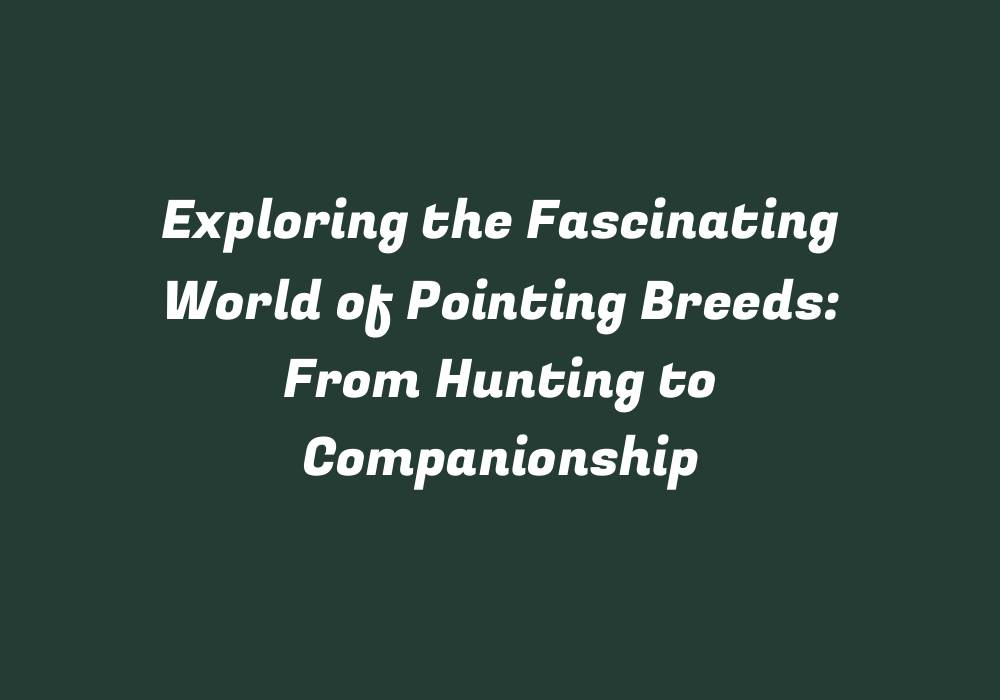## Exploring the Fascinating World of Pointing Breeds: From Hunting to Companionship
Introduction
Pointing breeds are one of the most diverse groups in the dog world, known for their unique characteristics and roles. These dogs have been developed throughout time due to their skills as hunting companions, watchdogs, farm helpers, and even pets. In this article, we will delve into the world of pointing breeds to understand where they come from, what they bring to the table, and how they can enrich our lives.
History and Origins
The origin of pointing breeds dates back to the early 15th century when gunsmiths started creating a new type of weapon that fired with much more force than previous firearms. This led to the need for specific hunting dogs who could locate and indicate the position of game birds, thus assisting hunters in their pursuit. The first pointing breeds were bred in Europe from crosses between hounds, spaniels, and setters.
As time passed, various dog populations spread across continents, and different countries started developing unique pointing breeds tailored to local conditions and preferences. This led to the wide variety of pointing breeds we have today. Some well-known breeds include the Vizsla from Hungary, the English Setter from England, and the Spanish Pointer from Spain.
Hunting with Pointing Breeds
Pointing breeds, such as the English Pointer, French Brittany, and German Wirehaired Pointer, have become key players in modern-day hunting scenarios. They possess a unique ability to locate game birds and other small animals by using their extraordinary sense of smell and sight. These breeds can work individually or together with other dogs and humans to navigate complex terrains and locate game effectively.
During the hunting process, pointing dogs use their instinctive behavior to mark the location of the game, often standing firmly in a “pointing stance” to signal their find. This allows hunters to determine whether they should continue the pursuit or not. The dog’s role extends beyond just locating prey; it also plays an essential part in flushing birds out of cover and retrieving downed birds from the ground.
Breed Diversity
Pointing breeds can be grouped into two main categories based on their size: large and medium-sized. Large pointing dogs include breeds like the English Pointer, German Shorthaired Pointer, and Irish Setter. Medium-sized dogs range from smaller setters to larger spaniels like the Clumber Spaniel.
There are also numerous variations within these categories, with each breed possessing its unique characteristics and adaptations to different hunting environments. For example, some breeds like the Vizsla were bred to point and retrieve birds on mountainous terrains, while others like the English Springer Spaniel excel in dense woodlands.
Working as a Companion
Pointing dogs are not only exceptional hunting companions but also versatile family pets. Many people find joy in living with these intelligent and loving breeds, even though they may need more physical exercise than other dog types due to their high energy levels.
While pointing breeds can work as watchdogs or assistants in various settings like farms and ranches, their primary role is to interact and bond with humans. They make excellent family pets because of their playful nature and strong desire for human companionship. These dogs have a natural ability to connect with people, making them great therapy dogs that bring comfort and joy to others. Moreover, their loyalty and unwavering devotion to their owners are some of the key characteristics that define pointing breeds.
Training Pointing Breeds
Training pointing breeds can be an incredibly rewarding experience for both dog owner and dog alike. The process involves teaching basic obedience, manners, and hunting skills to ensure a well-rounded education that enhances the dog’s abilities as both a working dog and companion animal.
Start with socialization from a young age to introduce your pointing breed to various environments and people. This will help develop a well-adjusted, confident, and friendly dog. Training should also include teaching your dog how to stay calm and focused during hunts while still responding to their “pointing” cue. Additionally, it is essential to work on retrieval skills with both birds and other game species.
Conclusion
Pointing breeds are a diverse group of dog breeds that boast a rich history as hunting companions and now serve various roles including family pets. Their unique characteristics make them an appealing option for those looking to adopt or work with dogs. By understanding their origins, understanding their abilities, and providing proper training, pointing breeds can bring immense joy, loyalty, and satisfaction to your life.
In summary, the fascinating world of pointing breeds offers a myriad of possibilities for both hunting enthusiasts and animal lovers alike. These versatile dogs have a rich history that has evolved over time in response to humans’ needs for hunting assistance and companionship, and now they offer a diverse range of roles spanning from dedicated hunters to devoted family pets.

Leave a Reply
You must be logged in to post a comment.